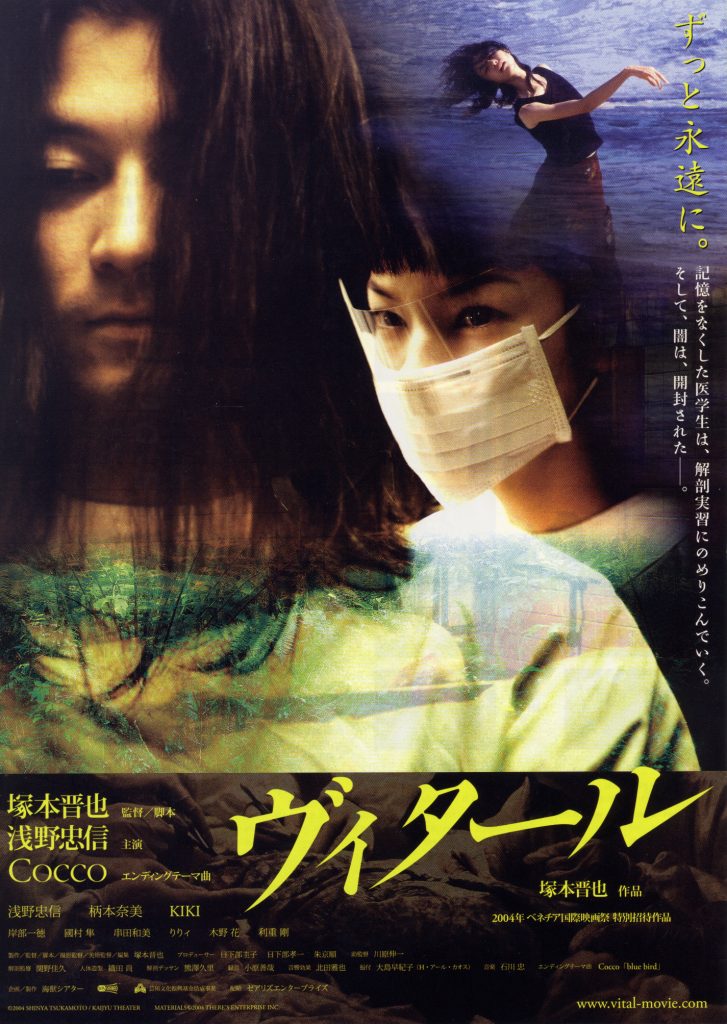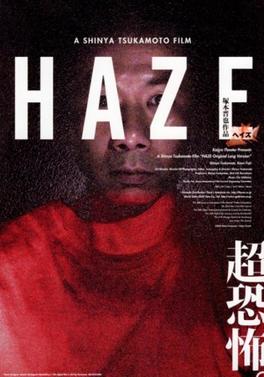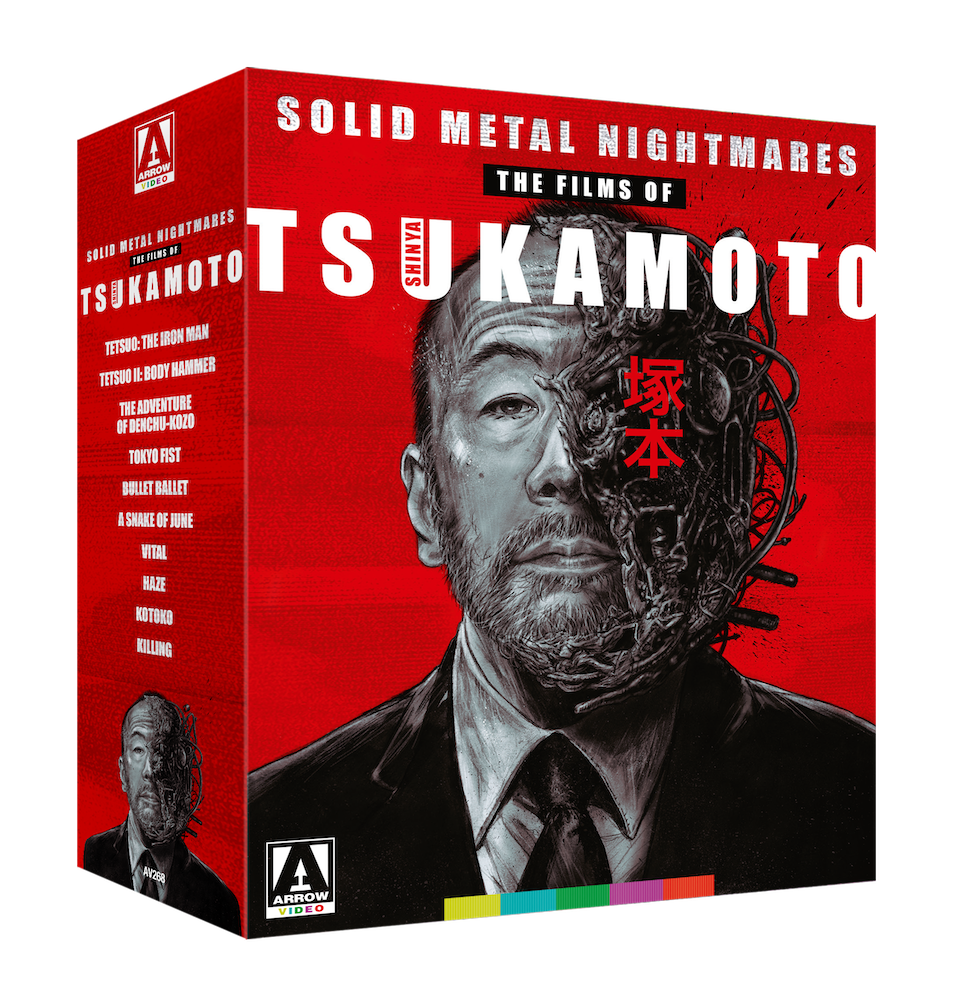Solid Metal Nightmares: The Films of the Shinya Tsukamoto is one of the best home video releases of 2020. It may be a little early to say this (it’s August as I write this), but this is my favorite release of the year. This boxset is a love letter to one of the most transgressive filmmakers and also a portal into one of the most exciting minds of World cinema. I’ve heard of Tsukamoto’s films for years, and to be honest, was a little scared of how his work would affect me. One of the best featurettes in this set is titled perfectly to describe his work, “An Assault on the Senses”. I wasn’t ready for the said assault, but now I feel like a changed man after seeing these 10 films ( 2 shorts, 8 Features).

Tsukamoto is one of the true underground voices in Japanese cinema. As film scholar and famous Midnight Eye writer Tom Mes describes in his excellent series of commentaries, Tsukamoto was a complete outsider. He came to the cinema after working in an experimental theatre and making amateur short films. While working in an advertising company, Tsukamoto made two exciting shorts and then started work on the oddity that would leave his mark as an artist, 1989’s Tetsuo: The Iron Man.
The first film in this set is the short The Adventure of Denchu-Kozu (1987, aka The Adventures of Electric Rod Boy). It tells the story of a teenager named Hikari, who has a strange electricity pole growing out of his back. He has to go through time, fighting evil punk vampires. Shot Super 8, Denchu-Kozu is a wild bit of sci-fi and comedy with surreal images. It was based on one of Tsukamoto’s plays. Instead of filming just the stage production, he went all out with a reimagined film that would feature some of his later directorial trademarks, including stop motion, sped-up footage, quick cuts, and off-centered framing. This short is a blast of energy and creative freedom. While it is rough around the edges, its pure fun.

Tetsuo: The Iron Man (1989) is Tsukamoto’s first feature and is a bit of a mission statement. Working on ideas first brought up in his short, The Phantom of Regular Size (1986) (which is not included in this set due to music rights issues), Tetsuo is an almost plotless odyssey into fear, sex, and the reawakening of the body. The outline of the story is about a metal fetishist who cuts open his leg and inserts a bar of metal. He soon becomes a new being that starts to grow metal. He is killed in a car accident. The driver and his girlfriend decided to hide the body and make matters worse by having sex in the woods in front of the dying man. The driver soon becomes haunted and turns into an Iron Man himself.
Tetsuo will be the movie that Tsukamoto will be remembered by, and for good reason. It’s one of the most bizarre and thrilling pieces of sci-fi. Every element of the film has seemed to influence pop culture ever since, including cinematic ideas of cyberpunk. Shot in gritty black and white, the movie is nearly 70 minutes of raw emotion. Ideas about sex, violence, and everyday life are turned on their collective head. It’s completely visceral and unconventional. The one shot that sums it up in my head is the close up of teeth as a pole of iron is scraped across the tips with the soundtrack letting out a sharp moan.
Tsukamoto puts the auteur theory to the test, as he acts, produces, edits, and directs this oddball masterpiece. The acting is loud and showcases some expressionism not seen since the silent era. Tomorowo Taguchi makes a likable lead as the driver whose life becomes linked with metal. Like most of the great Japanese horror stories, he showcases a great deal of repressed desire that pours out in an outburst of violence and lust. One of the best scenes is when his penis violently changes into a power drill that menaces and excites Kei Fujiwara (who would become a director in her own right with 1996’s Organ). Fujiwara’s performance is another brilliant addition to the film. She mixes her sexual energy with some of the weirdest scenes this side of David Cronenberg and Videodrome. An idea that was rejected from Videodrome that shows up here is the female partner suddenly growing a long, snake-like, penis and raping our male lead. The sequence is one of the most darkly beautiful.

Tetsuo 2: Body Hammer (1992) is a spiritual sequel that takes the elements of the body reawakening to a new level. Here we have another everyman (Taguchi again), whose life is changed when his son is kidnapped and murdered by a strange gang. This starts a series of body transformations that wakes up his sleeping violent side. Like the first Tetsuo, Body Hammer shows us the strange workings of the body and a waking up from the numbness of modern life. Here the story is more straight forward with an easier to follow plot. We see early on Taguchi’s excitement as he starts to hit the gym again and get his body into a new shape.
A new element is added to the mix with the love triangle, or at the very least three characters connecting and conflicting with each other. This is something that would continue to show up in most of Tsukamoto’s work. Here we have Taguchi, his wife played by the fabulous Nobu Kanaoka, and the mysterious metal man played by Tsukamoto himself again. This idea of three individuals fighting to become their true selves would burst with emotional flare with the next movie in the set.

Tokyo Fist (1995) is about a stressed out and subdue insurance salesman (Tsukamoto) whose life is changed when he bumps into an old school friend (Koji Tsukamoto, the director’s brother). It turns out that he has become a boxer and is now obsessed with challenging his salesman friend. The two men have some unfinished business from their youth. The boxer starts to weasel his way into the Salesman’s life where he meets his wife (Kaori Fuji). The two men start to fight over her as the marriage falls apart and she discovers herself.
Tokyo Fist is a huge jump forward for Shinya Tsukamoto in terms of directing and acting. It proved he was not just the weird sci-fi guy, but a truly original voice in World Cinema. Tokyo Fist is a masterpiece of human emotion with stunning performances from the three leads. Like the Tetsuo movies before it, it showcases the awakening of the body in a dulling modern world. Everyone is numb and in a mental haze. All three of the character start to discover themselves as they use their bodies more and escape the decay that was settling in. While truly violent with loud outbursts of sweat and blood, the film is deep down a poetic story of self.

1998’s Bullet Ballet is a completely different beast of a film. After the surprise suicide of his girlfriend, Goda (Tsukamoto) becomes obsessed with gang violence around him and purchasing a gun. Like the earlier films, we have a triangle of characters, but now a new element to the story: The influence of a dead character. The whole story is driven by a dead girlfriend. But instead of normal mourning, Goda becomes unglued and finds himself in a violent world that he wants to prove himself in. With touches of Martin Scorsese’s Taxi Driver, this a bizarre tale of discovery with some unexpected twists.

Next up in the set is another artistic masterpiece, A Snake of June (2002). It tells the story of a crisis center phone operator (Asuka Kurosawa) who unleashes her sexual desires when she is teased by a blackmailer (Tsukamoto) who caught her masturbating in public. With a sleazy sounding plot, this is an emotional and powerful fever dream of sexual desire, shame, and hope despite death around the corner. Shot in a poetic blue haze this is also one of the most visually striking films in the boxset. This movie is reviewed more in-depth for the Third Window Films Blu-ray release elsewhere on this site.

Vital (2004) is the next film in the set and a yet another exciting change in pace. Taking elements from Bullet Ballet, The story is focused around a man (Tadanobu Asano) who is recovering from a near-fatal car accident. It turns out that his girlfriend died in the crash, and he has lost his memory. As he starts to regain his former self he goes into medical school. But things start to change as he discovers that the corpse that he is dissecting in class is his dead girlfriend. Instead of responding with disgust or shock, he becomes obsessed with her as he sketches all of her body.
While hard to watch and haunting in nature, Vital is a sad love story that sees Tsukamoto pushes his themes further. The whole movie is kept together by a fine performance by Tadanobu Asano. He gives the story heart, even if his obsession is uncomfortable to watch. For the next film in the collection, Tsukamoto would return to the world of shorts.

2005’s Haze was commissioned by a digital film festival in South Korea. Originally released in a 25-minute version, Tsukamoto shot more material and made a “long version” at 49 minutes. This set includes the gut wrecking and claustrophobic long version. The story is simple and about a man who wakes in a small space made of concrete. It is dark and narrow. To make matters worse he has a cut in his abdomen. As he tries to escape he meets a mysterious woman and starts to piece together his former life. I won’t spoil the climax of the story, but the finished film is an intense story of loss and love.

By far the most challenging to watch film in this collection is the heartbreaking Kotoko (2011). Its a collaboration between Tsukamoto and J-Pop star Cocco, who share story credits. It’s almost a one-woman show about a single Mother (Cocco) who loses her baby due to her emotional state. She suffers double vision and sees odd violent versions of the people around her. The film pulls no punches in terms of the subject matter, and watching this woman suffer is gut wrecking at best.

The last film in this collection is also (to date) Tsukamoto’s latest film. Killing (2018) is one of the most haunting of the anti-samurai movies I’ve seen. Set during the mid-19th century, this is an ugly tale of the way of the warrior or the shallowness of this pride. Sosuke Ikematsu plays a ronin with excellent swordsman skills, but who has actually never killed a man. He is hiding out in a small farmer village enjoying his life until he sees an older ronin (Tsukamoto) kill a man in a duel. He knows something is wrong. This is confirmed when the Older man tries to recruit him to join his journey to Edo to overthrow the Shogun. At first, The young man agrees but things become messy when a group of unkempt and homeless ronin starts trouble in the village.
Killing is a complete backlash to any conventional samurai film. Like Clint Eastwood’s Unforgiven (1992), Killing is a bloodthirsty and emotional gut punch of a film. Everything is full of false faces and distrust. Our hero is so unwilling to fight that he spends most of the film sick in bed. This is top form Tsukamoto with all his themes present. The ideas of metal and the human body are more clear than ever. The samurai sword and slashing is shown in grisly detail. The death scenes are also unglorious and gross. Tsukamoto completely steals the show as the old ronin, whose cool persona is easily cracked to show a boling madman. By far one of the best films in this collection.
Arrow Films have done a fabulous job with this collection. The 1080p HD transfers are simply stunning with crisp detail and smooth black levels. There is only some minor print damage in terms of A Snake of June. It looks like some of the framing is off centered where you can see the top of the next frame before an edit comes. Haze has some digital noise due to the digital photography, but it’s hardly an issue. The menu even addresses this.
The Japanese tracks sound wonderful on all 10 films. There is no hiss or pops. English subtutles are included on all 10 films. Tetsuo The Iron Man, Tetsuo 2, and Tokyo Fist included their original 1.0 Mono audio tracks. Bullet Ballet and Haze have a 2.0 Stereo Mix. A Snake of June, Vital, Kotoko, and Killing have DTS-HD 5.1 Master Audio.
The collection is also packed with extras:
- Audio Commentaries on all 10 films by Japanese cinema expert Tom Mes. Each track is packed with information on the film and Tsukamoto himself. They are recorded mostly in order, so most of the tracks don’t overlap which is nice. I could relisten to these stunning tracks for hours.
- A new career-spanning interview with Shinya Tsukamoto.
- “An Assault on the Senses” a video essay by Jasper Sharp.
- Archival interviews with Tsukamoto on each film.
- Behind the scenes footage for A Snake of June.
- Making of Vital featurette.
- Venice film festival footage of Vital.
- Making of Haze.
- Kaori Fuji at the Locarno Film Festival interview.
- Music clips for Tokyo Fist, Bullet Ballet, and Vital.
- Image Galleries
- Trailers
- A double-sided fold-out poster
- And finally a collector’s hardback booklet of writings by Kat Ellinger, Jasper Sharp, and Mark Schilling.
Arrow Video has released one of the most prized sets of 2020. If your interested in the breathtaking work of Shinya Tsukamoto, then this is a essential purchase. I give it my highest recommendation possible.
Director- Shinya Tsukamoto
Cast- Various
Country of Origin- Japan
Distributor- Arrow
Discs- 4
Reviewer- Tyler Miller

